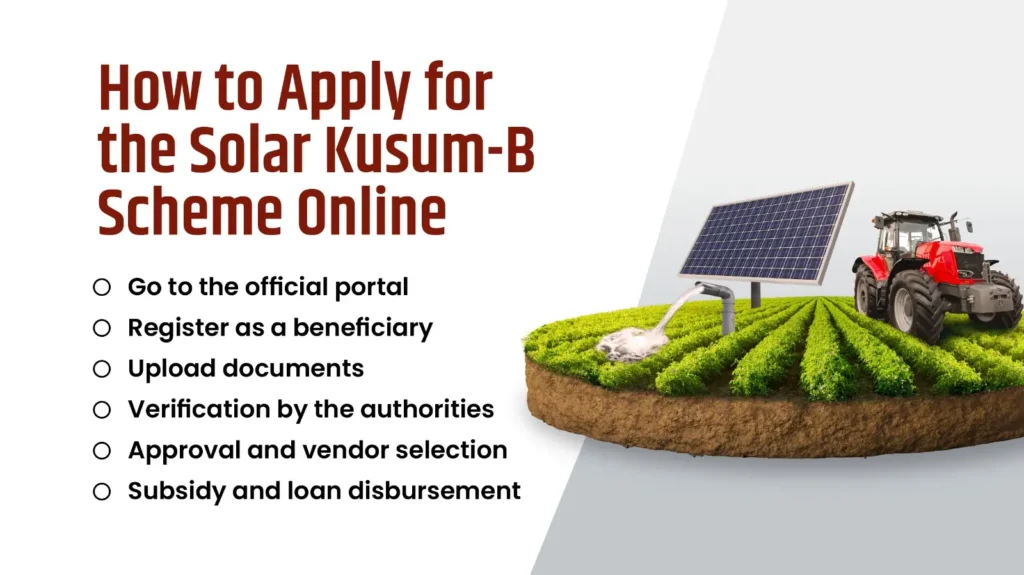Solar Kusum-B Yojana: Subsidy, Cost & Installation Guide
- Home
- Blogs

Irrigation is essential for farming but for many farmers, running irrigation pumps is a daily struggle. Diesel is costly, electricity is unreliable. And if there’s a delay in water, there will be no crops. Solar Kusum-B Yojana is what helps change this. Farmers get to install solar water pumps at an affordable cost with up to 60% subsidy support.
This blog will help you understand everything. Read on to learn who can apply, how much it costs, and what the installation guide is.
What is Solar Kusum-B Yojana? Overview of the Scheme
The Solar Kusum-B Yojana is a part of the much larger Pradhan Mantri Kisan Urja Suraksha evam Utthan Mahabhiyan (PM-KUSUM) scheme. Installing independent solar water pumping systems up to a maximum capacity of 7.5 HP is the main objective of Component B. Farmers who want to install solar-powered irrigation pumps can get financial assistance through the Solar Kusum-B Yojana.
These pumps are particularly well-suited for remote locations since they run on their own. Reducing dependency on grid electricity and diesel for agricultural irrigation is the aim. Farmers are eligible for up to a 60% subsidy under this program. This will make it affordable for them to switch to a cleaner and greener energy source.
Eligibility Criteria for Solar Kusum-B Yojana 2025
Individual farmers who own cultivable land.
Farmer Producer Organizations (FPOs), Primary Agriculture Credit Societies (PACS), and Water User Associations (WUAs).
Applicants must be in off-grid or partially electrified areas.
Farmers who currently use diesel pumps are given preference.
Those who are implementing micro-irrigation systems or efficient water management practices are also eligible.
How to Apply for the Solar Kusum-B Scheme Online

Are you looking for ways to apply for the Solar Kusum-B Yojana online? Then read on. Here’s the easy step-by-step process:
Go to the official portal
Visit the Kusum Component-B section of the MNRE website.
Register as a beneficiary
Find the option where you can fill in details like name, mobile number, Aadhar number, and land information.
Upload documents
You should keep the scanned copies of the necessary documents, like –
Aadhaar card
Photograph of the applicant
Land ownership proof
Address proof (ration card, voter ID, etc.)
Bank passbook or account details
Recent electricity bill (if applicable)
Verification by the authorities
Once you’ve uploaded the documents and your application is submitted, State Implementing Agencies (SIAS) will check the documents and verify them.
Approval and vendor selection
If the application gets approved, the names will be displayed on the portal. And after that, a registered vendor will be assigned to install the pump.
Subsidy and loan disbursement
The subsidy is given to the vendor directly. This reduces the installation costs for the farmers. Farmers can then pay their share through personal funds or loans.
Subsidy Details and Financial Assistance Under Kusum-B
The reason why many farmers are inclined towards the solar Kusum-B scheme is due to the generous subsidy structure. The government offers a great subsidy for the installation of pumps. Let’s see how it actually works.
Central Government Subsidy – 30% of the pump’s cost
State Government Subsidy – 30%
Farmer’s Own Contribution – 10 % of the total cost
Bank Financing – If there’s a need, farmers can opt for the remaining 30% as a loan
Farmers living in areas like the North-East, Himalayan states (Himachal Pradesh, Uttarakhand), etc, get up to 50% central government subsidy. The financial support is what helps the farmers greatly. Through this scheme, solar irrigation is made possible even for marginal farmers.
Cost Breakdown and Farmer Contribution in Kusum-B Scheme
The actual cost of a solar pump varies based on its capacity and location. But to give you a rough idea of its cost, here’s a general cost breakdown:
5 HP Solar Pump System
Total Cost: ₹1.5 lakh
Central Subsidy (30%): ₹45,000
State Subsidy (30%): ₹45,000
Farmer’s Contribution (10%): ₹15,000
Optional Loan (30%): ₹45,000
Step-by-Step Solar Pump Installation Process Under Kusum-B
Online Application
The farmer will need to register on the official PM-KUSUM portal and submit the required documents.
Verification and Approval
After all the necessary documents are submitted, the State Implementing Agency (SIA) will review the application.
Vendor Assignment and Payment
Once the application is approved, an authorised vendor is assigned. The farmer will pay their 10% share and complete their necessary formalities.
Installation and Training
The vendor installs the solar pump on-site. The farmer is then trained on how to operate the pump for better efficiency.
Maintenance Services
Maintenance services are mandatory for their smooth functioning even after years.
Benefits of Solar Kusum-B Yojana
For Farmers:
Cut Down on Farming Costs – By switching to solar powered pumps, farmers will eliminate the need for diesel and grid electricity. These options are costly; however, with the help of solar power, the farming costs will be lower to a great extent.
Access to Reliable Water Anytime – With different types of solar water pumps, farmers will no longer have to rely on grid electricity or fuels. They can irrigate their fields at daytime to ensure timely watering.
Low Maintenance, Long-Term Use – Solar water pumps require less maintenance than diesel pumps. These pumps work efficiently for years with minimal upkeep!
Boost in Crop Yield – You know what consistent and hassle-free irrigation means? Your crops get the water when needed. This leads to better crop growth, which directly boosts farmers’ income.
Conclusion
The Solar Kusum-B Yojana is more than just a subsidy scheme, it’s a movement that leads to sustainable and better farming. With low initial investment, long-term savings and environmental benefits. A trusted solar company, like KLK Ventures, will help farmers access the Solar Kusum-B Yojana and carry out a smooth and trusted installation process.
